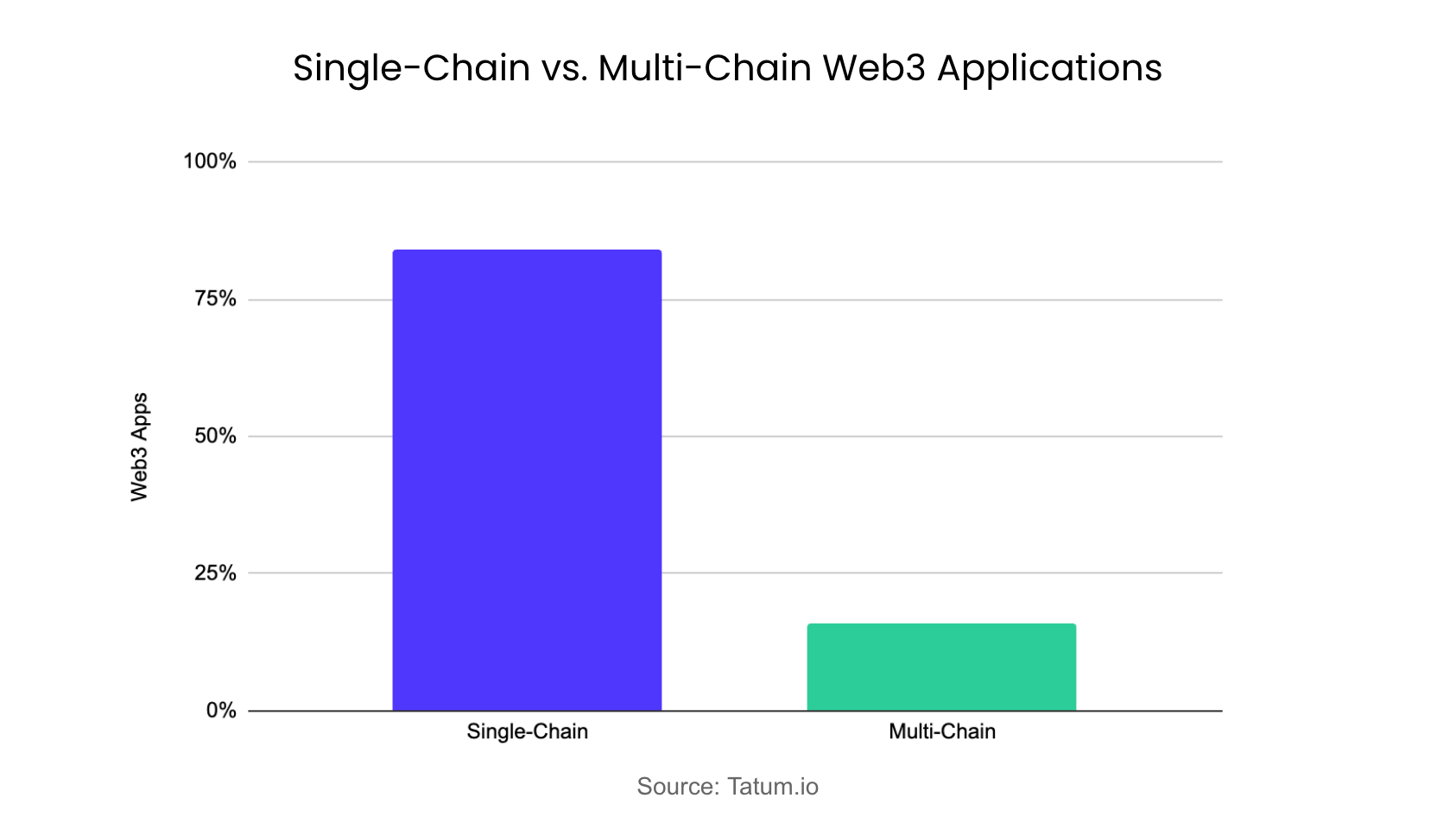From Single to Multi-Chain: A Necessary Change for the Next Gen of Web3 Apps



Blockchain technology and crypto have been around for over a decade now since Bitcoin’s first block was mined in 2009, and while adoption has multiplied and the industry has had time to mature and develop frameworks enabling faster, more efficient, and reliable application development there are unhealthy paradigms that are ingrained in how Web3 developers and businesses operate preventing further maturity and progress.
According to the most recent analysis from Tatum, an overwhelming majority, 84% of applications have been developed on a single blockchain, while only mere 16% have made multi-chain architecture the choice for their applications.

This stark contrast underscores a crucial aspect of blockchain development that requires attention for the long-term success of blockchain.
But why is single-chain a problem?
Let’s start with an analogy. Think of single-chain applications like having a favorite playground. It's fun, familiar, and you know every slide, swing, and sandbox there. But what happens when it gets crowded, or the slide is too hot, or, worse, it's closed for repairs? Your fun is over. That's not unlike building an app on just one blockchain, like Ethereum or Bitcoin. It's all great when everything's running smoothly, but if problems pop up, you're out of luck.
Now, imagine if you could play in multiple playgrounds all over town, each with its own set of unique slides, swings, and even some exciting new games you've never even tried before. If one playground is too crowded - no problem! Just hop over to the next one.
This is what multi-chain applications are like. They don't just stick to one playground – I mean, blockchain – they spread their fun across many, making sure they always have a place to play. This way, they're never stuck with a closed slide and always have the coolest new games to try.
The overwhelming preference for single-chain applications is not just a statistic; it reflects a deep-rooted challenge in the blockchain community. Single-chain applications, despite their initial simplicity and familiarity, present several inherent issues that can hinder their long-term viability and success.
Firstly, single-chain applications often face network congestion and high transaction fees, particularly on popular chains like Ethereum. This leads to an unsatisfactory user experience, characterized by slow transaction times and increased costs. In a digital age where speed and efficiency are paramount, such drawbacks can significantly impact an application's competitiveness and user retention.
Furthermore, the commitment to a single blockchain limits an application's flexibility and adaptability. If the chosen blockchain faces technological setbacks, security issues, or changes in governance, the application is directly and adversely affected. This lack of agility to adapt to changing circumstances can be a major hindrance, especially in an industry known for its rapid evolution.
Take one example, in 2022 40% of Solana validator nodes went down due to a server provider changing their policy. Do you want your application to be vulnerable to such eventualities?
Scalability is another critical concern. As an application grows, reliance on a single blockchain can become a bottleneck, restricting its ability to handle increased traffic and transaction volumes. This scalability issue can impede growth and deter potential users who seek reliable and efficient services.
Moreover, the focus on a single chain can stifle innovation. The blockchain ecosystem is rich and diverse, with each chain offering unique features and strengths. By restricting themselves to one blockchain, developers may miss out on opportunities to leverage these varied capabilities, limiting the scope of their creative and technological potential.
In blockchain development, adopting a multi-chain approach mirrors the wisdom of diversifying an investment portfolio. Savvy investors spread their assets across various classes to mitigate risks and enhance returns. Similarly, multi-chain applications distribute their operations across multiple blockchains, reducing reliance on any single blockchain's performance and thus bolstering their resilience.
Consider the example of data analytical tools within the blockchain ecosystem. These tools require access to a diverse range of data from various blockchains for comprehensive analysis. By employing a multi-chain strategy, they can efficiently gather and analyze data across different networks. This is vital, as depending solely on one blockchain might narrow the scope and depth of their analyses, akin to an investor limiting their investments to just one type of asset.
For a tangible example, consider a Web3 game that operates across multiple blockchains. Such a game can offer its players diverse assets and experiences from different blockchain ecosystems. It could mean smoother in-game transactions, broader digital asset compatibility, and a more resilient gaming environment. If one blockchain experiences delays or security issues, the game can maintain its operations seamlessly on other chains, ensuring continuous play without interruption. This not only diversifies risk but also future-proofs the game, making it adaptable to new developments and changes within the blockchain world.
Furthermore, the multi-chain framework significantly fosters innovation. Developers are not confined to the features and limitations of a single blockchain. Instead, they're encouraged to explore and amalgamate varied functionalities from multiple blockchains, driving progress and keeping a competitive edge in the rapidly evolving landscape of blockchain technology.
The current dominance of single-chain applications in the blockchain space calls for a paradigm shift. It's crucial to embrace a multi-chain approach to overcome these inherent challenges and unlock new possibilities for blockchain technology. This shift will pave the way for more robust, adaptable, and forward-thinking blockchain applications.
For developers and decision-makers in the blockchain arena, the message is clear: it's time to expand your horizons. Embracing the multi-chain approach will make you part of the movement reshaping the blockchain landscape into a more inclusive, versatile, and innovative domain.
Build blockchain apps faster with a unified framework for 60+ blockchain protocols.